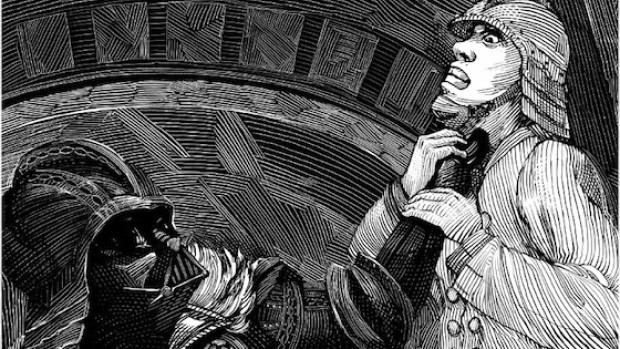WILLIAM SHAKESPEARE’S STAR WARS: VERILY, A NEW HOPE (10 out of 10) Written by Ian Doescher, illustrated by Nicolas Delort, published by Quirk Books 2013.
When I first saw the cover of “William Shakespeare’s Star Wars: Verily, A New Hope” flash across Twitter, I had two thoughts: the first was “This is blasphemy, and it must be stopped!” The second thought: “This must be a work of either genius or madness–either way, I must have it!” Ian Doescher’s adaptation of George Lucas’ original Star Wars screenplay to be in the style of the Bard of Avon has moments of genius, and moments of madness. I will say that for most of the time I was reading it, I had a stupid grin plastered on my face.
either genius or madness
Rewriting one of my favorite movies as a five act Shakespearean play could have fallen completely flat. I love Star Wars, I love Elizabethan English, whether in the form of Shakespeare’s plays or the poetry of the King James Bible, I genuinely love it. I was worried that Doescher’s treatment of the language would be poorly-written, or unnecessarily cluttered. Instead, what he’s done is take George Lucas’ script, translate it into iambic pentameter (really!), and discover more depth and meaning to key scenes and characters than I would have thought possible. I mean, I know Luke Skywalker, Darth Vader, Obi-Wan Kenobi and Princess Leia better than I do my own parents. I know their biographies, their passions, their fears…what could Ian Doescher possibly bring to the dejarik table that I don’t already have? Turns out, a lot.
_big.jpg)
Each major character gets asides and even soliloquys that I really love–some of those are expected, and just flesh out the characters. Some are for comedy’s sake–Han Solo gets most of those. What Harrison Ford may have expressed with a facial expression or body language is written out here as an aside, thrown with a wink or a sneer at an audience that isn’t actually there. This formatting as a play will be a barrier to some readers, even more than the four hundred year old language is, but I love it. Doescher uses stage directions and these asides and soliloquys to add new layers of depth to characters that don’t interfere with, but enhance our heroes and villains.
The best soliloquy is by Luke Skywalker, after seeing that his aunt and uncle have been killed by stormtroopers on Tatooine. I don’t want to put the whole thing in this review, but here’s a portion:
Adventure have I ask’d for in this life,
And now have I too much of my desire.
My soul within me weeps; my mind, it runs
Unto a thousand thousand varied paths.
My uncle Owen and my aunt Beru,
Have they been cruelly kill’d for what I want?
So shall I never want again if in
The wanting all I love shall be destroy’d.
O fie! Thou knave adventure! Evil trick
Of boyhood’s mind that ever should one seek
To have adventure when one hath a home–
I’ll cut Luke off there. On the screen, what we saw was Luke standing near his burned home, the smoking remains of his family. The next scene, he’s back with Ben Kenobi and the droids, and is clearly upset, but pretty much says “saddle up, Imma be a Jedi!” This scene at least gives him a few minutes to mourn his aunt and uncle and their blue milk, and summon the courage to go on to Alderaan.
gives him a few minutes to mourn his aunt and uncle and their blue milk
The book is richly illustrated by Nicolas Delort, who combines elements of Star Wars and Elizabethan dress in woodcut-inspired black and white drawings. So we have Grand Moff Tarkin in a high collar that accentuates his already gaunt features, and Darth Vader with a medallion seal of the Empire on his chest, and a fur-lined cloak in waves around his armored doublet. Jabba the Hutt sports a feathered Italian cap, and Han Solo wears knee-length breeches. We get pieces of how the sets could be designed and how the plays could be staged, which is another thing that boggled my mind. How would a play based on such special effects-intensive movies even work? I hope someone is thinking about these issues right now.

“Verily, A New Hope” was published last year, and “The Empire Striketh Back” and “The Jedi Doth Return” both came out in 2014. Both were excellent, and may have even exceeded this first entry in the trilogy. Like Shakespeare himself, Ian Doescher has taken a great idea (if not a new one) and run with it. I won’t say that it’s greater than the sum of its parts, but “William Shakespeare’s Star Wars” has made me consider that galaxy far, far away in a new light. And I’m grateful for it.